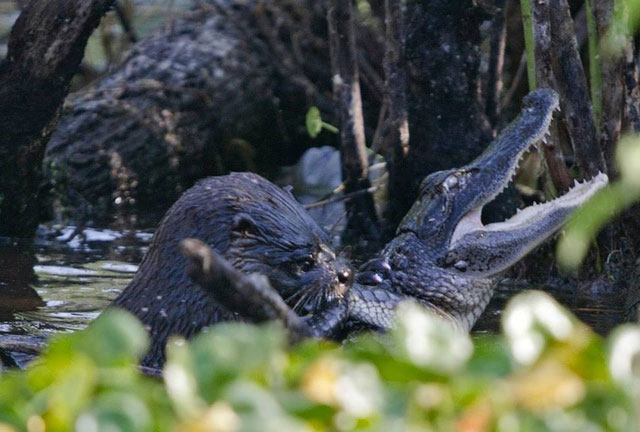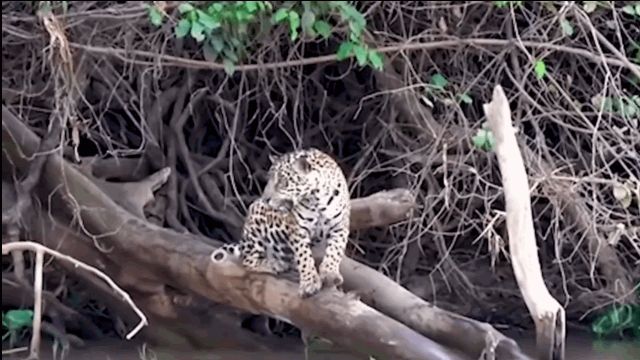Surprised by the animal that looks holy but makes crocodiles and leopards run away when they meet
After witnessing this adorable animal actively attacking crocodiles and leopards, scientists were extremely surprised .
By chance, a camera at Lake Woodruff National Park in Florida, USA, recorded a tragic attack between an otter and an alligator. Contrary to what many people think, the animal that was defeated and eaten was the alligator.

In the surprise battle, the otter easily defeated the crocodile. (Photo: Baidu)
According to the video, the otter easily pushed the crocodile against a tree, pinned it down and bit its back. Despite being of similar size, the crocodile had no chance to fight back.
In another video filmed in the Amazon, an otter calmly broke into the territory of a group of caiman crocodiles . Not only was it not afraid, it also carelessly lay "writhing" next to the cold-blooded "devils" . The crocodiles did not even react and instead tried to avoid it.

A daring otter enters crocodile territory and teases them. (Photo: Baidu)
Since then, many videos have been released of giant otters attacking caiman crocodiles in the South American jungle. In 2019, on the banks of the São Lourenço River, near Brazil's jaguar research station, Ailton Lara, director of Pantanal Nature, witnessed a jaguar running away in fear when it encountered a group of otters. It is hard to imagine that an animal with a cute face like an otter could scare away the so-called fearsome monsters of the Amazon forest.

The leopard was so scared by the otters that it "ran away in fear". (Photo: Baidu)
In the swamps of South America, the caiman is known as the haunting creature that lives here. The caiman and the American alligator are the two largest species of the family Alligatoridae still alive today. Caimans live mainly in wetland habitats throughout Central and South America.
Caiman is a large crocodile with a flat head with a slightly flattened snout and a long tail running along the body. They have strong jaws and sharp teeth so Caiman can tear apart prey easily.

Caiman crocodiles are known as formidable predators of Central and South America. (Photo: Baidu)
Caimans are formidable predators. Due to their primarily aquatic lifestyle, they feed primarily on fish, crustaceans, and small aquatic animals. They also commonly prey on birds (especially waterfowl) along with amphibians and mammals such as wild pigs…
Although caiman crocodiles have superior hunting skills in the swamp, they are no match for the giant South American otters.

Despite its superior hunting skills, the Caiman crocodile still had to give in to the otter. (Photo: Baidu)
Giant otters live across north-central South America, mainly on and along the Amazon River and the Pantanal. They are the longest of all the weasels, although sea otters can be heavier. Males range from 1.5 to 1.8 m in length and females from 1.5 to 1.7 m. The muscular tail of this species can extend up to 70 cm over the entire length of the body. However, there have been reports of exceptionally large males reaching 2.4 m in length. Male giant otters can weigh between 32 and 45.3 kg and females from 22 to 26 kg.

Despite their cute appearance, giant otters are formidable opponents of crocodiles in the Amazon. (Photo: Baidu)
Giant otters are excellent swimmers and divers due to their webbed feet and flat tails. They can swim at speeds of up to 14km/h and cover a distance of 100m in just 30 seconds. Giant otters spend most of their time in the water, catching and eating fish. They need to consume a large amount of food, usually 2.7kg - 4kg per day. In addition to fish, their diet also includes pythons, crocodiles, crustaceans and other marine creatures.
Giant otters have excellent eyesight for hunting. In addition to their eyes, they also use their whiskers to detect prey in the water by detecting changes in water pressure and currents.

Giant otters are nicknamed "river wolves" for their powerful fighting ability underwater. (Photo: Baidu)
Contrary to their friendly appearance, giant otters are also known as "river wolves" because they possess fighting abilities that are not inferior to jaguars when underwater . They often travel in groups and otters are not afraid of any scary predators, whether crocodiles or giant pythons.
Otters have sharp teeth and long claws, most importantly they are very intelligent, know how to observe and attack the weak points of their opponents . Each hunt of the giant otter is very fast and accurate, usually only lasting a few minutes. Therefore, it is not an exaggeration to say that otters are the natural enemy of crocodiles.

Giant otters are very intelligent and know how to attack their opponents' weak points. (Photo: Baidu)
Giant otters typically live in groups of 3 to 10. They mate year-round, but breed mainly during the dry season. Females are pregnant for 64 to 72 days and give birth to 1 to 6 cubs at a time. During the first month, otters only live in underground burrows and all members of the group will care for them together.
Two to three weeks after birth, the mother otter will let her cubs into the water to learn to swim. After one to two months, the cubs can swim well and hunt with the group. The cubs will stay with the group until they reach sexual maturity at 2.5 years of age.
- Interesting things about crocodiles
- Satan missed, the apricot newspapers were mercilessly beaten by the enemy
- Scary people who watch diver confront the giant crocodile in Mexico
- The ad in the holy city of Jerusalem stirred up the prophecy
- Detecting rare leopards in Lam Dong
- Hunting for humped pigs, leopards are dragged back to their nests
- Reckless close to giant crocodiles for 15 years
- Ancient crocodiles are vegetarian animals
- Found the legendary Holy Grail?
- Through 6 million years of evolution,
- He discovered the holy well
- Crocodiles are torn by lions because they dare to loot their lures
 Animal 'suffering' after hibernation
Animal 'suffering' after hibernation Why do goats climb well?
Why do goats climb well? Scientists were surprised to see chimpanzees eating turtles
Scientists were surprised to see chimpanzees eating turtles Giant catfish died deadly due to drought in Thailand
Giant catfish died deadly due to drought in Thailand